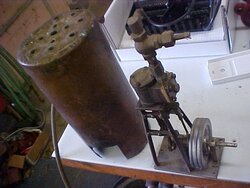There are a few companies that are close to making a small stirling engine for consumer use, around 6kw. In case you don't know what a stirling is, it's a motor that runs off of heat. It doesn't require fuel otherwise, and they have been around for centuries. See http://travel.howstuffworks.com/stirling-engine.htm. Currently they are used in some submarines to generate electricity off of the nuclear reactor's heat, and also as backup generators at power plants that run off of natural gas.
It looks like the engines will need a temperature around 600 degrees fahrenheit to get any real power. My idea is to run a high temperature coil into the firebox of my boiler and run a stirling which will turn a big truck alternator and generate 12V power. I will invert this and run it into the grid just as folks who generate solar do. Coil will have to be filled with oil or other non-volatile liquid. If I can generate 5kw, that's 3600 kw-h per month, enough even for a large home.
I just wish there was a way to do this with a gasifier, but I don't see how. Since they only burn for a couple hours, you're then limited to 200 degree in the thermal storage, which is too low. I'm going to be buying my boiler soon, and I think because of this I'm going to be forced to get a standard type as opposed to a gasification unit.
Ideas?
It looks like the engines will need a temperature around 600 degrees fahrenheit to get any real power. My idea is to run a high temperature coil into the firebox of my boiler and run a stirling which will turn a big truck alternator and generate 12V power. I will invert this and run it into the grid just as folks who generate solar do. Coil will have to be filled with oil or other non-volatile liquid. If I can generate 5kw, that's 3600 kw-h per month, enough even for a large home.
I just wish there was a way to do this with a gasifier, but I don't see how. Since they only burn for a couple hours, you're then limited to 200 degree in the thermal storage, which is too low. I'm going to be buying my boiler soon, and I think because of this I'm going to be forced to get a standard type as opposed to a gasification unit.
Ideas?


 It was my high school science project 30 some years ago.
It was my high school science project 30 some years ago.